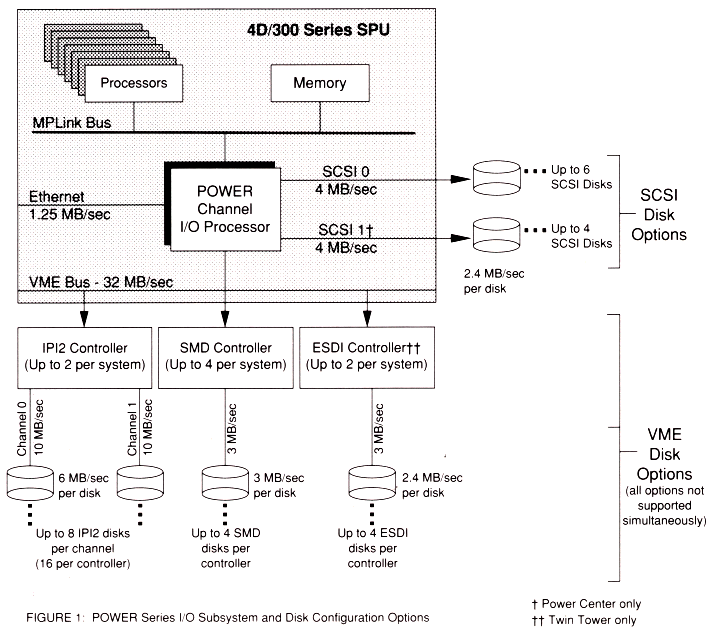Figure 1 illustrates the POWER Series disk configuration options. The POWER Channel I/O processor is the interface between the MPLink system bus and the I/O subsystem. The POWER Channel board includes two independent, synchronous SCSI buses, a high performance VME bus, and an Ethernet interface.
SCSI disk and tape devices are suported directly by POWER Channel. ESDI, SMD, and IP12 disks are supported through the addition of controllers on the VME bus. ESDI and SMD controllers provide one control channel per board; IP12 controllers provide two independent control channels per board.

It is important to note that all IP12 disk drives on the market do not offer comparable performance. Silicon Graphics offers the highest performance and largest capacity IP12 disk drives available. These drives are coupled with a highly integrated VME-based controller board that includes 1MB of on-board cache. Silicon Graphics uses a unique algorithm for dynamically managing this cache to optimize I/O performance based on patterns of recent disk activity. When moving data to and from CPU memory, the IP12 controller uses block-mode VME transfers at data rates up to 32MB/sec.
IRIX, Silicon Graphics' fully symmetric multiprocessing (SMP) version of UNIX, supports logical volumes and disk striping. Logical volumes allow a single UNIX file system to extend across multiple disk drives. Disk striping distributes a file system across multiple drives on a track-by-track or cylinder-by-cylinder basis in order to increase the data transfer rate. Striping of two drives will typically provide a data transfer speedup of 1.5X, and striping of four drives will provide a speedup in the range of 2X to 3X. Striping is supported on the SCSI, ESDI, SMD and IP12 interfaces. Drives that are striped together must all use the same interface and be of the same geometry. When using the ESDI and SMD interfaces, drives that are striped together must be configured on separate control/data channels. Multiple IP12 or synchronous SCSI drives on the same control/data channel can be striped together, though the performance improvement will be greater if separate channels are used.
IRIX includes other advanced features that maximize the disk performance user applications realize when working with the file system. For instance, IRIX's Extent File System employs many of the concepts underlying the BSD Fast File System (FFS), but achieves larger contiguous blocks (less disk fragmentation) with less software overhead than FFS.
IRIX's Integrated Data Cache (IDC) dynamically adjusts the size of the file system's buffer cache as needed to maximize system performance. IDC also reduces the copying of data between user and kernel memory space, thus increasing the sustainable I/O transfer rate and reducing the demands on the CPU, memory and system bus.
In multiprocessor systems with multiple disk controllers, disk interrupts can be directed to specific processors to balance each processor's work load and ensure fast response. Interrupt asignment is specified by the system adminstrator at system generation ("sysgen") time.
Before adding a disk product to our peripheral offering, Silicon Graphics performs an extensive design and quality evaluation of the disk subsystem. Controller firmware and the IRIX driver are tuned as needed to optimize the performance of every disk drive offered. once in production, every disk drive is extensively tested at our factory prior to shipment. All disk drives shipped from the Silicon Graphics factory are formatted, and the IRIX operating system is installed on all system disks. The results of this process are exceptionally high performance and high reliability implementations of industry standard disk subsystems.
SCSI ESDI SMD IP12
Drive Capacity
Unformatted (MB) 380,780 380,780 1230 1153
Formatted (MB) 340,645 320,642 985 833
Drives per controller 7 4 4 16
Controllers per system 2 [+] 2 4 2
VME Slots per controller 0 1 1 1
Form Factor 5.25" 5.25" 8" 8"
Disk Performance (rates in MB/sec)
Peak Transfer rate 2.4 2.4 3 6 Sustained transfer rate [*] 1.8 1.8 2.3 3.6 Rotation Speed (rpm) 3600 3600 3600 3600 Average seek (ms) 16 16 16 15
Disk Striping
System chassis [**] Rack TT TT.Rack TT.Rack Drives striped 2 2 2, 3, 4 2, 3, 4
Controller Features
Cache size (KB) n/a 128 128 1024
Bandwidth (MB/sec) 4 3 3 10
Command grouping no yes yes yes
Command queuing no yes yes yes
Seek optimization no yes yes yes
Overlapped seeks yes yes yes yes
Zero latency reads no yes no yes
Read-ahead yes yes yes yes
Dynamic read-ahead control no no no yes
[+] Second SCSI controller requires POWER Channel option
[*] Sequential reads through the file system from a single drive. SCSI
and ESDI rates are for 780MB drives.
[**] TT-Twin Tower deskside enclosure - requires additional peripheral
rack for SMD or IP12; Rack-POWER Center rack enclosure
Corporate Office
2011 N. Shoreline Boulevard
Mountain View, CA 94043
(415) 960-1980